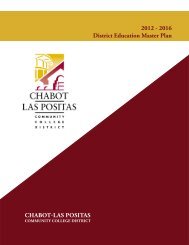City College of San Francisco - California Competes
City College of San Francisco - California Competes
City College of San Francisco - California Competes
Create successful ePaper yourself
Turn your PDF publications into a flip-book with our unique Google optimized e-Paper software.
STANDARD II.A<br />
<strong>College</strong> Curriculum Committee Handbook and<br />
the Office <strong>of</strong> Instruction and <strong>College</strong> Curriculum<br />
Committee websites. [Ref. 10] These websites<br />
provide faculty access to all necessary forms for<br />
submitting new curriculum or revising existing<br />
curriculum to the <strong>College</strong> Curriculum<br />
Committee. The Handbook and other related<br />
documents are also found on these websites.<br />
In particular, the Office <strong>of</strong> Instruction website<br />
provides faculty access to all course outlines <strong>of</strong><br />
record maintained by the institution. Currently,<br />
this database includes approximately 3,000<br />
course outlines.<br />
II.A.2.b. The institution relies on faculty expertise<br />
and the assistance <strong>of</strong> advisory committees<br />
when appropriate to identify competency levels<br />
and measurable student learning outcomes for<br />
courses, certificates, programs including general<br />
and vocational education and degrees. The institution<br />
regularly assesses student progress towards<br />
achieving those outcomes.<br />
Student learning outcomes and competency<br />
levels are measured by the ability <strong>of</strong> students to<br />
successfully complete a course, pass into higher<br />
levels <strong>of</strong> academic study, enter a licensed pr<strong>of</strong>ession,<br />
advance in a current pr<strong>of</strong>ession, or move<br />
from noncredit coursework to credit coursework.<br />
All vocational departments are required to<br />
collaborate with an advisory committee when<br />
identifying those competencies that graduates<br />
need to have in order to enter the labor market.<br />
Many also use these committees to help determine<br />
how student learning outcomes should be<br />
assessed. This partnership between the faculty<br />
and an advisory committee is required among<br />
those programs accredited by an external agency.<br />
For example, the Diagnostic Medical Imaging<br />
Program uses an advisory committee to measure<br />
success in areas such as on-the-job competency<br />
and the pr<strong>of</strong>essionalism <strong>of</strong> its graduates. [Ref. 16]<br />
Moreover, some vocational programs have<br />
undergone the DACUM process in order to<br />
identify competency levels and measurable<br />
student learning outcomes in their curriculum.<br />
While assessment <strong>of</strong> student learning outcomes<br />
has not occurred at the institutional level, there<br />
are several examples <strong>of</strong> this type <strong>of</strong> assessment<br />
that should be noted:<br />
a. The Photography Department has worked<br />
to determine standards and evaluation<br />
techniques for assessing student competency<br />
based on established student learning<br />
outcomes.<br />
b. The English Department has developed a<br />
common exam for English 94. This exam is<br />
not required to pass the class, but is used by<br />
faculty to serve as a reference point to judge<br />
student competency regarding course-level<br />
learning outcomes. The department, in<br />
deciding to raise the English Graduation<br />
Requirement, used data collected from the<br />
common exam. (See also Theme II Essay<br />
in this Self Study.)<br />
c. The English as a Second Language Department<br />
assesses outcomes in both credit and noncredit<br />
programs. Credit ESL has end-<strong>of</strong>-semester tests<br />
in reading, writing and grammar for their core<br />
courses (i.e., ESL 110-150). This division also<br />
has a composite final for ESL 82. In the area<br />
<strong>of</strong> noncredit ESL, there are end-<strong>of</strong>-semester<br />
reading and listening tests for ESLN 3200,<br />
3400 and 3600. The CASAS test is also used<br />
to assess a student’s attainment <strong>of</strong> life skills<br />
and competencies. Instructors use the results<br />
<strong>of</strong> this test to decide which competencies need<br />
to be emphasized in class.<br />
II.A.2.c. High-quality instruction and appropriate<br />
breadth, depth, rigor sequencing, time to<br />
completion and synthesis <strong>of</strong> learning characterize<br />
all programs.<br />
The institution has a formal review process in<br />
place to ensure all instructional programs<br />
include the appropriate breadth, depth, rigor,<br />
and sequencing and can be completed within an<br />
acceptable time frame. The <strong>College</strong> Curriculum<br />
CITY COLLEGE OF SAN FRANCISCO<br />
117







